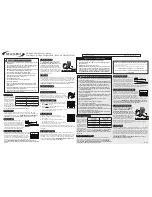
Prior to assembly and adjustment always
unplug the tool
MOUNTING THE CORRECT ACCESSORY
This tool is supplied with a set of accessories for different
applications.
Image Description Purpose
Glass Protector Nozzle Ensures direct heat is
kept off glass.
Reflector Nozzle
Wraps around a metal
pipe to distribute the
heat evenly around the
pipe surface.
Flat Nozzle
For spreading the hot
air over a narrow area
that is wide.
Reducer Nozzle
Concentrates heat over
small areas.
Scrapper
Stripping paint and
varnish.
• Make sure that the tool is switched off and the nozzle has
cooled down.
• Set the desired accessory onto the nozzle.
• Always observe the safety instructions and
applicable regulations.
• Use only one hand to hold the tool (fig. 2). Do
not place your other hand over the air vents (fig. 3).
PRIOR TO OPERATION:
• Mount the correct accessory for the application.
SWITCHING ON AND OFF (FIG. 4)
• To switch the tool on, set the on/off switch to position 1.
• To switch the tool off, set the on/off switch to position 0.
• Let the heat gun cool down before moving or storing it.
SETTING THE TEMPERATURE (FIG. 5)
• Switch the tool on to position 1.
• Select -ºC / +ºC to decrease / increase the temperature.
The air temperature can be adjusted to suit a wide range of
applications. The table below suggests settings for different
applications.
Setting
Applications
Low (1st sector)
• Drying paint and varnish
• Removing stickers
• Waxing and dewaxing
• Drying wet timber prior to filling
• Shrinking PVC wrapping and
insulation tubes
• Thawing frozen pipes
Medium (2nd sector) • Welding plastics
• Bending plastic pipes and sheets
• Loosening rusted or tightly fastened
nuts and bolts
High (3rd sector)
• Removing paint, varnish and lacquer.
• If you are not sure about the correct setting, start with a low
temperature setting and gradually increase the temperature
until you achieve optimum results.
ADJUSTING THE SPEED / AIRFLOW (FIG. 6)
• Switch the tool on to position 1.
• Set to the desired temperature.
• To adjust the speed / airflow incrementally press the fast /
slow button until required speed is found
To achieve a greater airflow repeat this stage with the on/off
switch in position 2.
Alternatively, if the highest speed / airflow is required
instantaneously, you can slide the on/off switch to position 3.
STRIPPING PAINT (FIG. 7)
• Mount an appropriate accessory.
• Switch the tool on.
• Set a high air temperature.
• Direct the hot air on to the paint to be removed.
• When the paint softens, scrape the paint away using the
hand scraper.
• Do not strip metal window frames, as the heat
may be conducted onto the glass and crack it.
• When stripping other window frames, use the
glass protector nozzle.
• Do not keep the tool directed at one spot too
long to prevent igniting the surface.
• Avoid collecting paint on the scraper accessory,
as it may ignite. If necessary, carefully remove
paint debris from the scraper accessory using a
knife.
www.evolutionbuild.com
6
www.evolutionbuild.com
7
COOLING DOWN
The nozzle and accessory become very hot during use. Let
them cool down before attempting to move or store the
tool.
• To reduce the cooling time, switch the tool on at the lowest
air temperature and let it run for a few minutes.
• Switch the tool off and let it cool down for at least 30
minutes.
Consultant your dealer / Evolution for further information on
the appropriate accessories.
MAINTENANCE
Your Evolution Power Tool has been designed to
operate over a long period of time requiring very little
maintenance. Continuous satisfactory operation depends
upon proper tool care and regular cleaning.
LUBRICATION
Your power tool requires no additional
lubrication.
CLEANING
Keep the ventilation slots clear and
regularly clean the housing with a soft
cloth.
Congratulations on purchasing an Evolution Power Tool.
Please complete and mail your product registration card.
Doing so will validate your machine’s warranty period and
ensure prompt service if needed. We sincerely thank you for
selecting a product from Evolution.
Technical Helpline UK: 0870 609 2297
Technical Data
HDG200
Voltage 230v
Power input
2000w
Air temperature range (at nozzle)
50 – 630ºC
Airflow speed
120-550 Ltr/min
Weight 0.8kg
The following symbols are used throughout this manual;
Denoted risk of personal injury, loss of life
or damage to the tool in case of non-observance
of the instructions in this manual.
Denotes risk of electric shock.
EC-Declaration of conformity
HDG200
We, Evolution Power Tools Limited, Venture One, Longacre
Close, Sheffield, S20 3FR as the supplier of the product
stated below:-
Evolution HDG200 Heat Gun
Declare that this Power Tool has been designed in compliance
with: 2006/95/EEC, 98/37/EEC, 2004/108/EEC, EN55014,
EN50144, EN 60335, EN 61000-3-2 & EN 61000-3-3.
For more information, please contact Evolution at the
address (above), or contact the technical helpline.
Level sound pressure according to 86/188/EEC & 98/37/EEC,
measured according to EN 50144:
HDG200
Lpa (sound pressure) db(A)*
75
Lwa (acoustic power) db(A)
88
* at the operator’s ear
Take appropriate measures for the protection of
hearing if the sound pressure of 85 db(A) is
exceeded.
Weighted root mean square acceleration value according to
EN 50144:
HDG200<2.5 m/s2
All relevant technical documentation is held at Evolution
Power Tools Ltd, Sheffield (UK).
Authorised by:
Mr Matthew J Gavins
Managing Director
HDG200 HEAT GUN
ASSEMBLY AND ADJUSTMENT
GB
INSTRUCTIONS FOR USE
GB
EC - DECLARATION OF CONFORMITY
GB
Summary of Contents for HDG200
Page 5: ......























